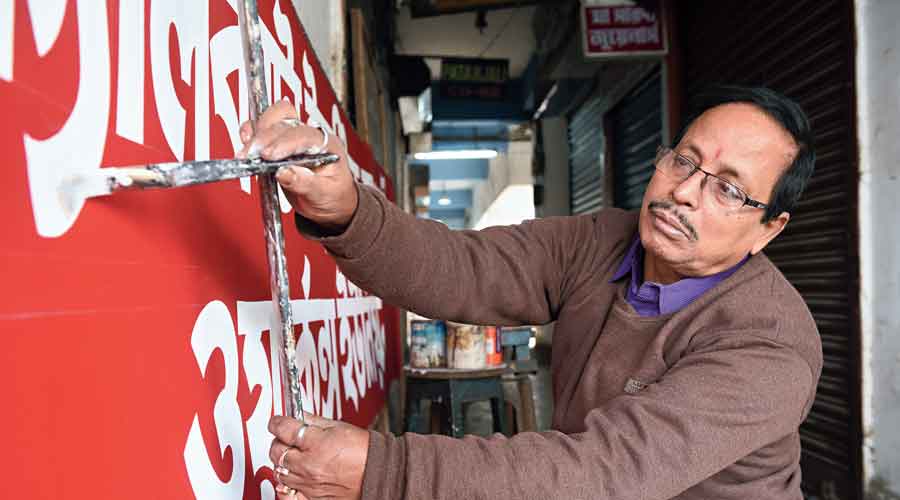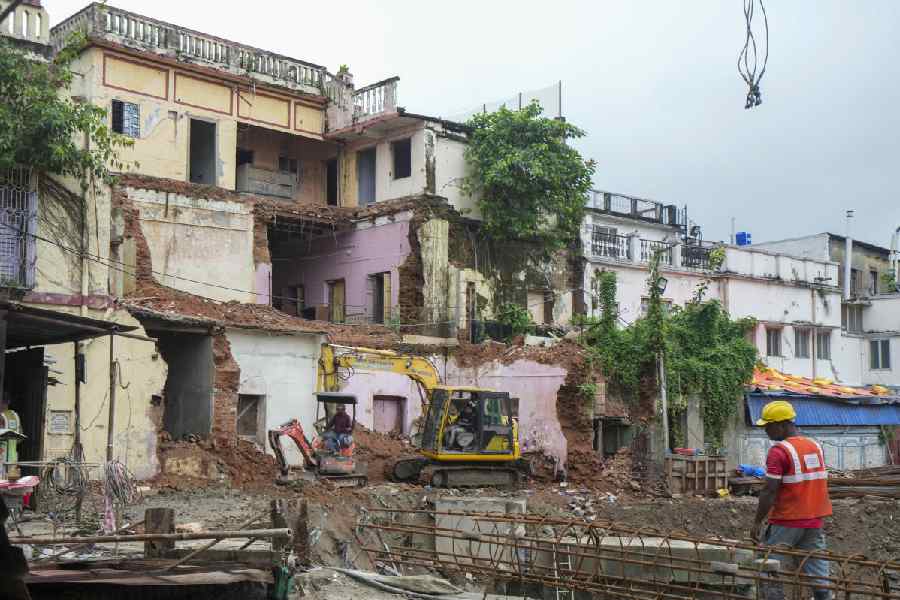When Shambhu Chakraborty began his work as an apprentice signboard painter in the mid-70s, he was about 12. A signboard painter would then “draw” the letters, designed by himself, and also do the artwork that often accompanied the lettering. He would also be asked to draw portraits, of famous personalities, for political and cultural events, or compose “sceneries” that would form the backdrop of a puja or in a photo studio. A skilful signboard or scenery painter would be called an artist.
Chakraborty, 58, is the owner of Kalpana Arts, a name well-known in the city since the late 70s for its neat, elegant signage and humble charges. He is still considered an artist, but his profession has changed drastically since he began.
Not much art is left in it. But Chakraborty’s spirit, and his passion, remain.
Kalpana Arts, which stood proudly at the Golpark-end of the Gariahat boulevard, on the vanguard of the long row of delightful shops, is now reduced to one small room on the first floor of the Gariahat market building on the side that overlooks Rashbehari Avenue. Chakraborty can be found on the balcony, a solitary figure putting finishing touches to a signboard, his working hand placed on a rest so that it does not go too close to the board, or in his shop a few feet away, cluttered with signboards and glow signs, but mostly metal nameplates. He has an assistant who is not around. Clustered around the shop are other one-room shops: a tailoring shop where clothes are both stitched and altered; a little away, a stationery store specialising in printing materials and a shop known for its framed pictures of the goddess Kali.
All of them look slightly desolate, as if abandoned in an upper storey when the “real” market of fish, meat, vegetables, groceries and every household item teems at the ground level, a mini universe bursting with life. Many of the shopkeepers in the upper three floors of the market building owned shops in Gariahat Road or the boulevard, and were evicted in 1996 by Operation Sunshine, a drive to end hawkers’ shops in the city.
Chakraborty’s stint at the boulevard had been a glorious one. His family had crossed over from Chattagram, Bangladesh, around 1970, and settled in Bauria, in Howrah. Chakraborty had six siblings. Kalpana, after whom his shop is named, was one of the sisters.
The large family found it hard to make both ends meet. Chakraborty joined his elder brother’s sign painting shop when he was 12. His elder brother had set up the shop in Bauria.
“My brother was a true artist,” says Chakraborty. “He had imagination. We had no prescribed fonts,” says Chakraborty.
“He would make signboards and banners, in Bengali, Hindi, English and Urdu, which we still do. He would also draw portraits and sceneries, and make cutouts. He would design the cover of jewellery boxes, both the lettering and the design.”
From his brother, Chakraborty learnt the basics of signboard painting: sorting of letters by size — M, W or O are the widest letters in English — or how to choose the thickness of a letter. The rest was instinct. “We drew freehand,” says Chakraborty. He would acquire some basic idea of fonts later — “Arial, Brush, Park Avenue” — but his lettering was mostly his own. He loved the work. It gave him joy.
In 1977, he started his shop in the boulevard and it caught on. His biggest clients were political parties. “I worked for every party,” says Chakraborty. In the 80s and 90s, with the CPM in power, and Mamata Banerjee gathering strength, there was no dearth of work. Sometimes up to 20 persons were employed in a day.
Plus there was work for signboards for shops and establishments. “I have forgotten how many people I have worked for.” He has worked for big enterprises, such as Bharat Biscuit, Polar Fans
or Indian Oil, and also a few distinguished organisations, such as Ramakrishna Mission, Lalit Kala Akademi and Nari Seva Sangha. “For a sari block-printing shop the design would be ‘modern’,” says Chakraborty. The lettering could be slender, ornamental, striking. The boulevard had a few block-printing shops, too, which seem to have vanished. Not much of Chakraborty’s old work remains, either. Signage is ephemeral.
Then Operation Sunshine struck. And so did computer technology, from the mid-90s. “They happened together. Everything changed,” says Chakraborty, who, by then, was a resident of Garia.
Out of the boulevard, he first set up shop in Panchanantala, and from 2000, he relocated at the first-floor Gariahat shop.
His work has now been completely transformed by technology. The signboard is there, but overwhelmed by the flex banner, glow signs and LED and SEP lighting. Chakraborty has adapted to all of this. But the processes are almost totally controlled by technology.
Chakraborty’s daughter Priyanka Banerjee, a computer engineer, does the designing entirely on the computer now for him. In case of a signboard, he may draw the letters designed by Priyanka by hand on the board. In case of a flex banner, he has no role to play.
But nothing has changed more than letters. Fonts available on computers, with their speed and accuracy, have killed hand-drawn lettering. If also the creativity of a person like her, Priyanka says.
The volume of his work has gone down significantly. “But my father still goes to the shop every day, sometimes also on Sundays,” says Priyanka. “He can’t help it.”
Chakraborty’s mainstay now is the nameplate, on metal, wood and plastic. These are also designed digitally by his daughter, but he does the metalwork himself. On a rare occasion someone comes with a special request for hand-drawn lettering on a nameplate. Then he does everything.











